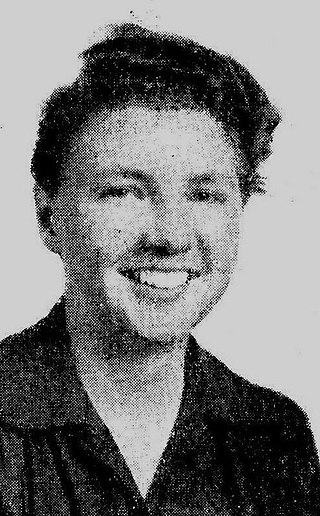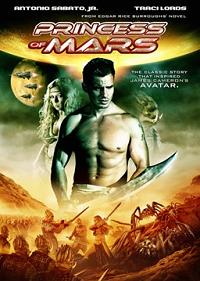
Edgar Rice Burroughs was an American writer, best known for his prolific output in the adventure, science fiction, and fantasy genres. Best known for creating the characters Tarzan and John Carter, he also wrote the Pellucidar series, the Amtor series, and the Caspak trilogy.

Mars, the fourth planet from the Sun, has appeared as a setting in works of fiction since at least the mid-1600s. Trends in the planet's portrayal have largely been influenced by advances in planetary science. It became the most popular celestial object in fiction in the late 1800s, when it became clear that there was no life on the Moon. The predominant genre depicting Mars at the time was utopian fiction. Around the same time, the mistaken belief that there are canals on Mars emerged and made its way into fiction, popularized by Percival Lowell's speculations of an ancient civilization having constructed them. The War of the Worlds, H. G. Wells's novel about an alien invasion of Earth by sinister Martians, was published in 1897 and went on to have a major influence on the science fiction genre.

Leigh Douglass Brackett was an American author and screenwriter. Nicknamed "the Queen of Space Opera," she was one of the most prominent female writers during the Golden Age of Science Fiction. As a screenwriter, she was best known for her collaborations with director Howard Hawks, mainly writing Westerns and crime films. She also worked on an early draft of The Empire Strikes Back (1980), elements of which remained in the film; she died before it went into production.
BBV Productions is a UK-based video and audio production company founded in 1991, specialising in science fiction drama. The company has expanded to include publishing of novels and scripts associated with its productions.
Faction Paradox is a series of novels, audio stories, short story anthologies, and comics set in and around a "War in Heaven", a history-spanning conflict between godlike "Great Houses" and their mysterious enemy. The series is named after a group originally created by author Lawrence Miles for BBC Books' Doctor Who novels.

The Virgin New Adventures are a series of novels from Virgin Publishing based on the British science-fiction television series Doctor Who. They continued the story of the Doctor from the point at which the television programme went into hiatus from television in 1989.

Professor Bernice Surprise Summerfield, or simply Benny, is a fictional character created by author Paul Cornell as a new companion of the Seventh Doctor in Virgin Publishing's range of original full-length Doctor Who novels, the New Adventures. The New Adventures were authorised novels carrying on from where the Doctor Who television series had left off, and Summerfield was introduced in Cornell's novel Love and War in 1992.
Lance Parkin is a British author. He is best known for writing fiction and reference books for television series, in particular Doctor Who and as a storyliner on Emmerdale.
Iris Wildthyme is a fictional character created by writer Paul Magrs, who has appeared in short stories, novels and audio dramas from numerous publishers. She is best known from spin-off media based on the long-running British science fiction television series Doctor Who, where she is sometimes depicted as a renegade Time Lord.

The Ice Warriors are a fictional extraterrestrial race of reptilian humanoids in the long-running British science fiction television series Doctor Who. They were originally created by Brian Hayles, first appearing in the 1967 serial The Ice Warriors where they encountered the Second Doctor and his companions Jamie and Victoria. In Doctor Who, the Ice Warriors originated on Mars, which within the series narrative is a dying world. Their early appearances depict the Ice Warriors as attempting to conquer the Earth and escape their planet as early as Earth's Ice Age. A frozen group are discovered by an Earth scientific team, one of whom, Walters, dubs them 'Ice Warriors' in their first appearance. Despite this not being the name of their species, an Ice Lord later refers to his soldiers as Ice Warriors in the 1974 serial The Monster of Peladon. Similarly there is a fleeting reference to themselves as such in The Curse of Peladon. Although originally appearing as villains, subsequent appearances have depicted Ice Warriors that have eschewed violence and even ally themselves with the Doctor. They have also been featured in flashback and cameo appearances, in addition to appearing frequently in spin-off media such as novels and audio releases.

Lungbarrow is an original novel written by Marc Platt and based on the long-running British science fiction television series Doctor Who. Published in Virgin Books' New Adventures range, it was the last of that range to feature the Seventh Doctor.
Mark Clapham is a British author, best known for writing fiction and reference books for television series, in particular relating to Doctor Who and Warhammer 40,000.

The Dying Days is an original novel written by Lance Parkin and based on the long-running British science fiction television series Doctor Who. It was last of the New Adventures range to feature the Doctor and the only one of that range to feature Paul McGann's Eighth Doctor. Thereafter the series centred on the character of Bernice Summerfield. The Dying Days features the classic series monsters, the Ice Warriors and is strongly influenced by The War of the Worlds.

Just War is a novel by Lance Parkin from the Virgin New Adventures. The New Adventures were based on the long-running British science fiction television series Doctor Who. The novel featured the characters of the Seventh Doctor, Bernice Summerfield, Chris Cwej and Roz Forrester.

Cold Fusion is an original novel written by Lance Parkin and based on the long-running British science fiction television series Doctor Who. It features the Fifth Doctor, with Adric, Nyssa, and Tegan, immediately after Castrovalva. Also appearing is the Seventh Doctor, with Chris and Roz, from between the Virgin New Adventures novels Return of the Living Dad and The Death of Art. It was the only one of the Virgin Doctor Who novels to feature more than one Doctor.

Twilight of the Gods is a novel by Mark Clapham and Jon de Burgh Miller from the Virgin New Adventures with the fictional archaeologist Bernice Summerfield as its main character. The New Adventures were based on the long-running British science fiction television series Doctor Who. Twilight of the Gods was the twenty-third and final New Adventure featuring only Bernice after Virgin lost the licence to publish original Doctor Who fiction.

The Gallifrey Chronicles is a BBC Books original novel written by Lance Parkin and based on the long-running British science fiction television series Doctor Who. It was the last of the Eighth Doctor Adventures range and features the Eighth Doctor, Fitz Kreiner, and Trix MacMillan. This book, along with a few others in the series, was reprinted in 2011 and is available as an e-book.

Princess of Mars is a 2009 direct-to-DVD science fiction film made by American independent studio The Asylum, loosely based on the Edgar Rice Burroughs novel A Princess of Mars (1917). The film's promotional art mentions how the original story inspired some elements of the James Cameron film Avatar (2009), but neither the credits nor promotional material mention Edgar Rice Burroughs. It is not to be confused with the higher-budget science fantasy film John Carter (2012), which is a direct adaptation of the novel. In the UK, the film was released with the title The Martian Colony Wars, and in other international markets with the title Avatar of Mars.
Lars Pearson is an American writer, high school teacher, editor, and journalist. He is the owner/publisher of Mad Norwegian Press, a publishing company specializing in reference guides to television shows including Buffy the Vampire Slayer, Angel and Doctor Who, plus the Faction Paradox range of novels and comic books. He is also co-author, with Lance Parkin, of "Ahistory: An Unauthorized History of the Doctor Who Universe," which puts every Doctor Who-related story onto a single timeline from the beginning of the universe to its end.
Pilot Pirx is a fictional character introduced in 1966 in the science fiction stories of Polish writer Stanisław Lem: ten short stories. Later he appeared in the novel Fiasco.













